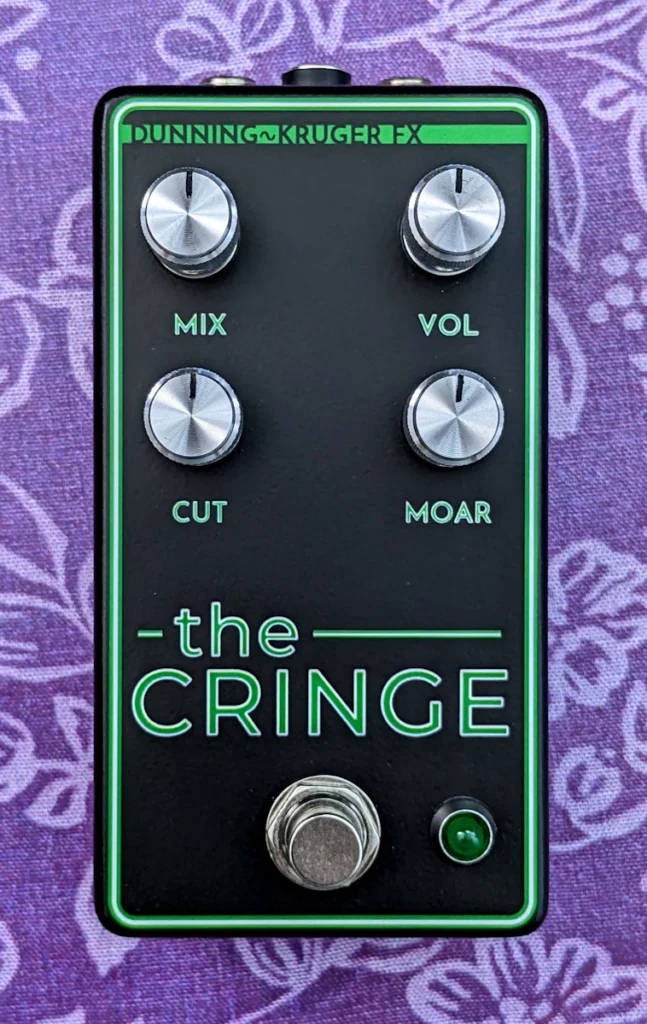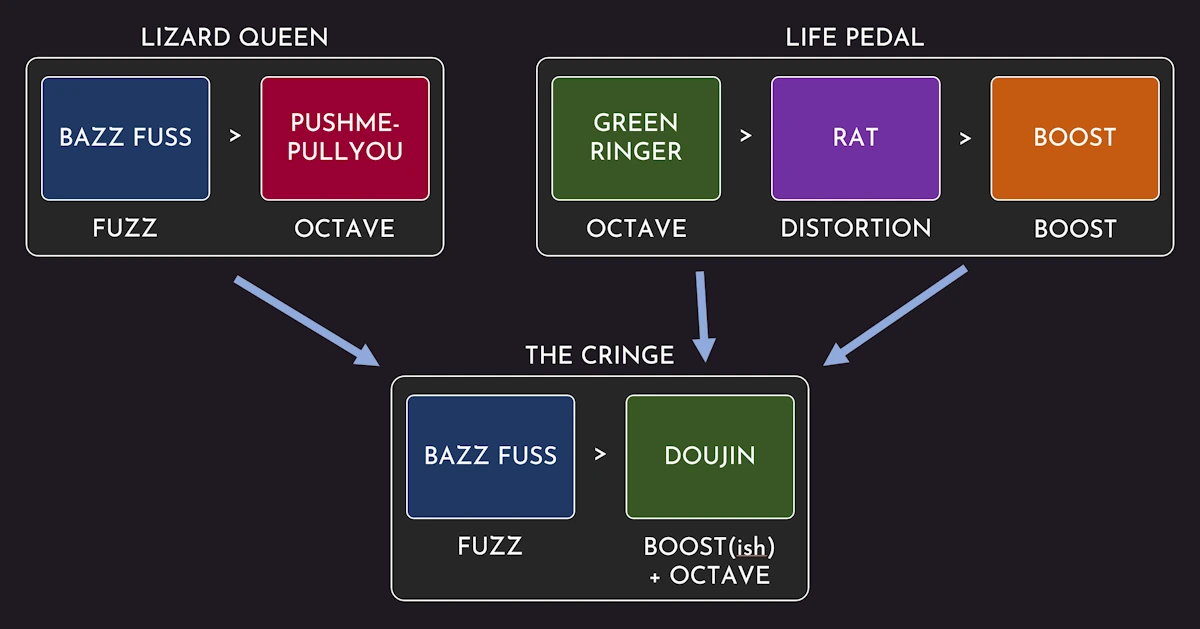

Yikes
You don’t just introduce yourself to someone you’ve met before: you realize it 80% of the way into doing it and try to back out of it with an elaborate series of excuses, crude lies, and a stammering breakdown of grammatical syntax.
You “replied all” on that work email, and no amount setting your computer on fire or crawling under your desk seems to unsend it.
You’re trying to go to sleep and your brain reminds you of that time that you said something dumb when you were eleven years old, which causes an organ in your chest to squish out a double shot of the shame hormone, you reenact Pee Wee Herman’s death scene in Buffy, and you wonder how you can rewind your entire life and fix it.
You claim that a pedal you designed is completely original.
These are examples of what the children would call “cringe,” as an adjective, since language is entropic. The Cringe pedal is similarly a mess, but makes up for it in volume.
Details
It seems like a bunch of newer guitar pedals are really a couple long-established pedal designs stuck together. Like JHS recently put out a pedal with Electro-Harmonix called the Lizard Queen. In almost the time it took for it to sell out, the pedal nerdiverse had already identified it as Bazz Fuss (a classic DIY fuzz circuit, made of like five parts) and a Pushme Pullyou (an octave up designed by Tim Escobedo). There are some tweaks and part substitutions, but the general topology of those circuits is there. Similarly, the Earthquaker Devices Life Pedal is basically a Green Ringer (a Dan Armstrong octave/quasi-ring mod) into a Rat (classic Pro-Co distortion) with a clean boost. I’m not disparaging the practice—there’s barely anything new in analog pedals, and as long as they’re not going to great lengths to obfuscate it, it doesn’t bother me. In fact, I can do it too:

The Cringe is basically a Bazz Fuss into a Green Ringer. The Bazz Fuss part has a Darlington transistor for max chaos and is contained (to the extent to which it can be contained) within a blender so that it can mixed with the clean signal. It also has a variable bass cut on the input, lifted from dylan159’s Pinched Face, which makes it sound a little more like a distortion than a wide-open fuzz. The octave section is the Doujin, a collaborative work of the Audio Electronics DIY community, which is an updated Green Ringer plus a bonus fuzz control (which I accidentally named “Moar,” hoping to come up with a better but equally brief label later).
Vital Stats
Sound
There’s a lot going on. The blend control goes from clean to completely-Bazz, so there’s a lot of control on how much fuzz is being fed into the Doujin. The Doujin also has its own fuzz of a slightly different flavor, and they can be mixed to taste. The bass cut is great. I didn’t realize the full potential of it when I was breadboarding and testing it on an amp with a 3″ speaker, but on a real amp, it completely changes the character of the fuzz. I kind of wish that I had put it more upstream in the circuit so that it could affect both halves of the effect. As-built, it’s only on the Bazz Fuss, so if that’s bypassed via the mix knob, the cut doesn’t do anything. In fact, both sources of fuzz can be bypassed to get it back to a classic Green Ringer sound. In my limited time with it, I find myself turning knobs completely one way or the other far more often than with other pedals.
The following sample is in four parts, all of which are Emomaster > The Cringe > Fender Deluxe:
- Part 1: A few notes with the effect disengaged, then immediately into just the ringer effect with the fuzz turned off. There are some individual notes, which get an octave up sound, then some power chords (with no changes to the pedal) that sound far more messy/distorted/almost ring modded.
- Part 2: The “Moar” knob turned up, adding the fuzz from the Doujin circuit.
- Part 3: Bazz Fuss engaged, about half way on the blend knob (although the Bass Fuss dominates the mix in general when it’s on at all), with the cut knob all the way up (or down? It sounds all backwards to talk about it, like how high pass filters cut lows, but it’s set the most Fuzz Face-y way).
- Part 4: Same as Part 4 but with the cut knob all the way down (or at least the opposite of Part 3; the more “distortion-y” way). I’m not sure how obvious it is in this sketchy recording, but it real life, the cut knob makes the effect noticeably smoother, despite the fact that the octave up can’t be turned off and is inherently a bit fizzy.
Or this.






